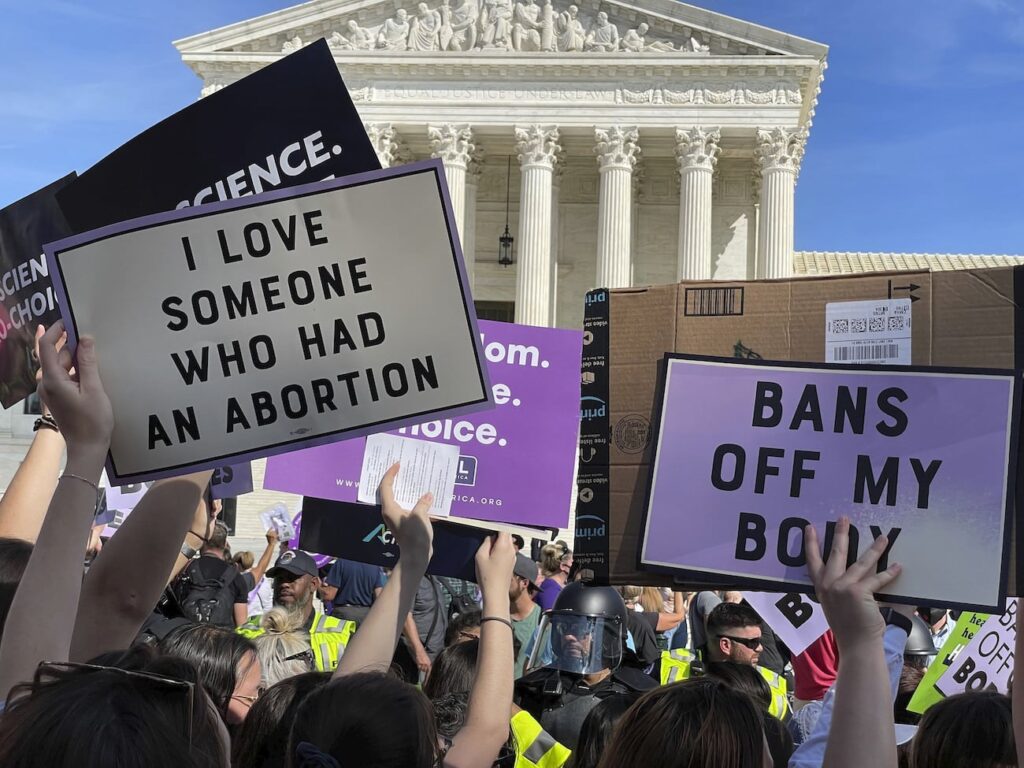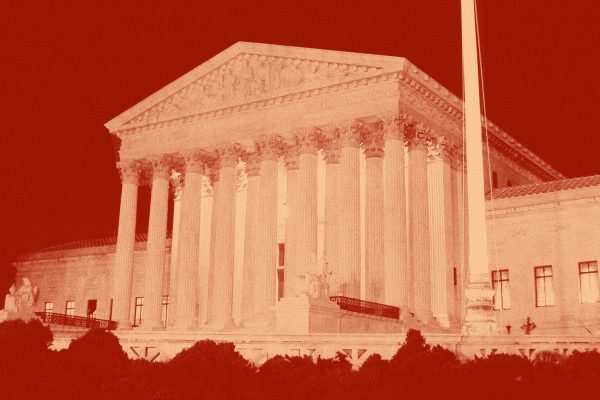To discuss the aftermath of Dobbs v. Jackson Women’s Health Center, Boston Review spoke with Rachel Rebouché about innovative legal responses and the conflicts likely to unfold between states and the federal government. A leading scholar of reproductive health law and feminist legal theory, Rebouché has written before in these pages about abortion access and what reproductive justice requires.
Boston Review: Dobbs took away a federal right to abortion and seems to return abortion law to the states. Yet you point out that the end of Roe will entail complicated and ongoing fights between states and the federal government over borders and jurisdictions. What will those battles look like? Where will they be fought? And what do they mean for American federalism?
Rachel Rebouché: With Roe v. Wade overturned, states now have broad leeway to restrict and ban abortion at any stage of pregnancy. The legal landscape, as well as how people gain access to abortion, will depend on where one lives. This was always true to a large extent; well before the Dobbs decision, so-called “abortion deserts” existed in the South and Midwest. Those regions had few providers, and they all operated in states with heavy restrictions on abortion care.
But until now, even the most restrictive states could not ban abortion entirely; the constitutional minimum established by Roe (1973) and Planned Parenthood v. Casey (1992) prevented as much. The widely discussed Texas Heartbeat Act (SB 8), which went into effect last September, was an attempt to do the most that could be done in a Roe legal landscape: it banned abortion after around six weeks anddeputized citizens to enforce the ban through civil lawsuits. SB8 remained in force not because the Supreme Court held it was constitutional; indeed, as a pre-viability ban, it was unconstitutional under Casey and Roe. It stood because Texas successfully made a procedural argument about who could sue and when. Now, after Dobbs, Texas can and will ban all abortion, excerpt perhaps in very limited circumstances: it will no longer need to rely on procedural maneuvering.
Yet Texas and states with similar intentions will not stop at banning abortion within their borders. The ultimate aim of the anti-abortion movement is to put an end to abortion throughout the country. This spring, before Dobbs, Missouri considered a bill that would impose civil liability on those helping Missouri citizens travel out of state to obtain an abortion. This ambition runs up against nearly half the states’ permission for or advancement of abortion rights, some explicit, following Dobbs.
The result, as we are already seeing, will be conflict between states that seek to ban abortion and states that seek to protect it. Several states have passed laws protecting in-state providers—as well as their patients and people who assist them—from out-of-state penalties. At the same time, the current federal government, given the Biden administration’s recent pledge to protect abortion rights, could intervene using its federal powers—over land and through preemption, for example—to blunt the effect of state abortion bans.
We can thus expect marked conflict among states, and between states and the federal government. These conflicts will undermine the state-by-state cooperation so many Americans have taken for granted. Our federalist system ensures the right to enjoy the protections offered in other states that are not our own and anticipates that states will cooperate with, or at least not burden, each other. Policies that seek to apply one state’s law outside its borders, as well as those that shield providers from another state’s reach, undermine those foundational values.
BR: In light of this new landscape, many have expressed concern that people who live in a state that outlaws abortion will be prosecuted for seeking abortions in another. Is that likely to happen? What role will abortion medication prescribed via telehealth play?
RR: At present, state laws banning abortion target providers, not the people seeking abortions. But that could change given the changing nature of abortion care. As a practical matter, state bans on abortion might be difficult to enforce given that contemporary abortion, at least early in pregnancy, is effectively and safely accomplished using medication abortion—the two-drug regimen before ten weeks of pregnancy. In states where it is legal, virtual abortion services have proliferated.
This growth follows the decision by the Food and Drug Administration (FDA) last December to lift the requirement that people collect medication abortion in person at a health care facility. But even in states that ban abortion (including medication abortion), people circumnavigate those restrictions using internet services that work with international providers and pharmacies to order otherwise-banned medication abortion. Once pills are in the mail, they become difficult, though not impossible, to police. But providers that prescribe the pills from outside a state’s jurisdiction become harder to punish.
Some states may turn to surveilling and attempting to directly penalize the people that seek out medication abortion online. We know, based on the past and what we have seen already since Dobbs, that poor people and people of color will be prosecuted disproportionately. And even without laws that directly target people seeking to terminate a pregnancy, prosecutors nonetheless could use their prosecutorial powers by applying ordinary criminal laws in the abortion context.
That said, states intent on enforcing abortion bans and potentially applying them out of state face not only practical difficulties but also potential legal challenges. Restricting travel or applying the law of one state outside its borders could invite constitutional challenge, under, for example, constitutional protection of the right to travel or of interstate commerce. But, to reiterate, possible unconstitutionality is unlikely to thwart the most anti-abortion legislators.
BR: What do you make of Justice Kavanaugh’s remarks about a constitutional right to travel? How will the new abortion laws challenge norms about jurisdictions and state borders?
RR: The Supreme Court has interpreted the Due Process Clause of the Fourteenth Amendment to protect an individual’s right to travel. Other constitutional provisions protect the ability of states to participate in interstate commerce and of residents of one state to avail themselves of the protections and resources of another. Justice Kavanaugh’s Dobbs concurrence invokes the Due Process protection of the right to travel, though his statement could encompass other sources of constitutional protection as well. But whether it is constitutional for abortion bans to have extraterritorial effect may not be as clear cut as he suggests.
Moreover, the Due Process Clause’s application to rights not enumerated in the Constitution has been a source of disagreement and controversy. Justice Alito sought to distinguish abortion from all other rights protected by the Due Process Clause in the Dobbs opinion. As many have opined, though, his analysis—that only rights rooted in a long history and explicit text of the Constitution deserve protection—could leave other rights vulnerable. Justice Thomas’s concurrence offers a blueprint for why: he argues that the Due Process Clause offers no substantive protections at all. In short, while there has long been a right to travel in this country, the scope of its enforcement is not clear.
BR: To go back to what you said above: What role will state surveillance play in all this? What does Dobbs mean for privacy?
RR: Actually enforcing state laws banning abortion means trying to ascertain who is breaking those laws. On this score, we might expect state officials to deploy their own means of surveillance as well as enlisting the assistance of health care providers and other intermediaries. But there are limits to what health information a state may access under federal law. For example, the Health Insurance Portability and Accountability Act (HIPAA) prohibits health care providers from disclosing peoples’ private health information to law enforcement unless a statutory exception is met. One such exception is when providers are served with a summons, warrant, subpoena, or administrative request for private medical information. For this exception to apply, however, the provider would be responding to law enforcement, not initiating contact.
This June, the Biden Administration clarified how HIPAA interacts with abortion crimes, attempting to make clear what federal privacy protections dictate. The Department of Health and Human Services (HHS) could modify the regulations to explicitly exempt abortion-related crimes. Doing so would preempt contradictory state law.
BR: What can legal efforts on behalf of abortion rights learn from social movements? And what role can movements play in advancing legal victories?
RR: In many ways the struggle for or against abortion rights has always been shaped by social movements. But the way forward, after Dobbs, will depend on what choices movement actors make. Over the last fifty years, we have seen the anti-abortion movement tirelessly chip away at Roe and Casey, at times losing and at times winning. Their strategies tested the understanding of what the Constitution requires, as SB8 demonstrates. With Roe overturned, the anti-abortion movement will need to pivot in pursuit of abortion bans that reach across the country. The abortion rights movement, by contrast, will need to change its approach, too, adopting its own novel strategies. Those strategies will challenge who can regulate abortion and how—between states themselves, and between states and the federal government—and must wrestle with the reality of how people seek abortion care on the ground. But the status quo is not an option and given the increasingly complex legal and access landscapes, now is the time for bold action.
BR: You argue that “the supremacy of federal law provides a novel and untested argument for chipping away at state abortion bans” and suggest there’s precedent for the use of federal law to preempt abortion bans. How?
RR: Federal law preempts state law in areas where the federal government has power to regulate, and as suggested by Biden’s executive order, HHS Secretary Xavier Becerra’s guidance, and the remarks of Attorney General Merrick Garland, the current administration supports strategies that assert federal authority over aspects of state abortion regulation. The supremacy of federal law could undercut state abortion bans in significant ways, but it is also important to note that this is an underdeveloped area of law, and its development will be left to federal courts.
To take one example, the FDA has closely regulated medication abortion, specifically the first drug in the regimen (mifepristone), since approving it in 2000. The FDA invests decades of research into a drug’s efficacy and safety before allowing it to enter the market; Congress assigned the FDA this duty by statute. States that seek to ban an FDA-approved drug therefore contradict the FDA’s congressionally granted authority. Indeed, states typically do not ban FDA-approved drugs. If FDA regulation preempts contradictory state laws, states’ bans on medication abortion contrary to FDA policy would not survive.
Other federal powers could likewise protect access to in-person and telehealth abortion, such as those that govern the use of federal land. To take another example, state law does not always apply on federal land, so abortions provided on leased federal land within antiabortion states might not be subject to state bans. And even if state criminal laws are incorporated on federal land, federal prosecutors can exercise their enforcement discretion not to charge people with abortion crimes. So, without a federal law banning abortion in “exclusive enclaves,” abortion would be legal.
There are risks to offering abortion on federal land; states will target abortion providers, potentially along with patients and those who assist, with punitive measures once they step foot back on state land. As with all untested ideas, some risks may not be worth taking. But there are costs to not trying to understand what is possible and what might be worth the risk.
Editors’ Note: This interview draws from Rebouché’s research and writing with David S. Cohen and Greer Donley, reflected in their forthcoming article, “The New Abortion Battleground,” in the Columbia Law Review.








